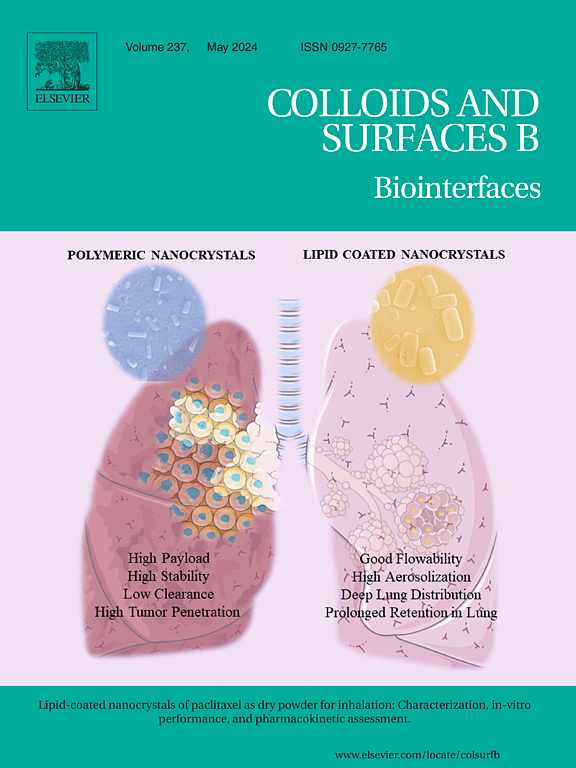绿茶多酚/壳聚糖双功能水凝胶促进骨再生
IF 5.6
2区 医学
Q1 BIOPHYSICS
引用次数: 0
摘要
2019年全球报告了约4.55亿例骨折病例,比1990年增长33.4% %。骨折影响患者的健康状况和生活质量,给家庭乃至社会带来沉重的负担。骨组织工程是利用复合支架治疗骨缺损和骨折的一项创新技术。然而,该技术缺乏有效的双功能材料来诱导骨再生。我们在此开发了一种具有抗菌性能、良好生物相容性和适当机械强度的结构和组成仿生天然骨组织的骨组织工程支架。通过光交联和希夫碱交联制备甲基丙烯酸明胶、羧乙基壳聚糖、绿茶多酚和氧化透明质酸,形成交联双功能水凝胶。通过场发射扫描电镜观察了水凝胶的形貌。采用力学万能试验机对其力学性能进行了测试。体外细胞相容性也得到验证。最后,利用动物模型揭示了体内修复机制。双功能水凝胶具有与骨组织相似的结构和力学性能,具有良好的生物相容性,促进骨再生。本文章由计算机程序翻译,如有差异,请以英文原文为准。
Bone regeneration enhanced by green tea polyphenols/chitosan bifunctional hydrogel
Approximately 455 million fracture cases were reported globally in 2019, which is an increase of 33.4 % from 1990. Fractures affect the health status and quality of life of patients and bring a heavy burden to families and even society. Bone tissue engineering is an innovative technology in which composite scaffolds are used to treat defects and fractures. However, this technology lacks efficient dual-function materials for inducing bone regeneration. We here developed a bone tissue engineering scaffold with a structural and compositional bionic natural bone tissue having antibacterial properties, good biocompatibility, and appropriate mechanical strength. Methacrylated gelatin, carboxyethyl chitosan, green tea polyphenols, and oxidized hyaluronic acid were prepared through a photo-crosslinking reaction and Schiff base crosslinking to form a crosslinked dual-function hydrogel. The morphology of the hydrogels was observed through field-emission scanning electron microscopy. The mechanical properties were explored using a mechanical universal testing machine. The in vitro cell compatibility was also verified. Finally, the in vivo repair mechanism was unveiled using an animal model. The dual-function hydrogel exhibited a structure and mechanical properties similar to the bone tissue and good biocompatibility, and promoted good bone regeneration.
求助全文
通过发布文献求助,成功后即可免费获取论文全文。
去求助
来源期刊

Colloids and Surfaces B: Biointerfaces
生物-材料科学:生物材料
CiteScore
11.10
自引率
3.40%
发文量
730
审稿时长
42 days
期刊介绍:
Colloids and Surfaces B: Biointerfaces is an international journal devoted to fundamental and applied research on colloid and interfacial phenomena in relation to systems of biological origin, having particular relevance to the medical, pharmaceutical, biotechnological, food and cosmetic fields.
Submissions that: (1) deal solely with biological phenomena and do not describe the physico-chemical or colloid-chemical background and/or mechanism of the phenomena, and (2) deal solely with colloid/interfacial phenomena and do not have appropriate biological content or relevance, are outside the scope of the journal and will not be considered for publication.
The journal publishes regular research papers, reviews, short communications and invited perspective articles, called BioInterface Perspectives. The BioInterface Perspective provide researchers the opportunity to review their own work, as well as provide insight into the work of others that inspired and influenced the author. Regular articles should have a maximum total length of 6,000 words. In addition, a (combined) maximum of 8 normal-sized figures and/or tables is allowed (so for instance 3 tables and 5 figures). For multiple-panel figures each set of two panels equates to one figure. Short communications should not exceed half of the above. It is required to give on the article cover page a short statistical summary of the article listing the total number of words and tables/figures.
 求助内容:
求助内容: 应助结果提醒方式:
应助结果提醒方式:


